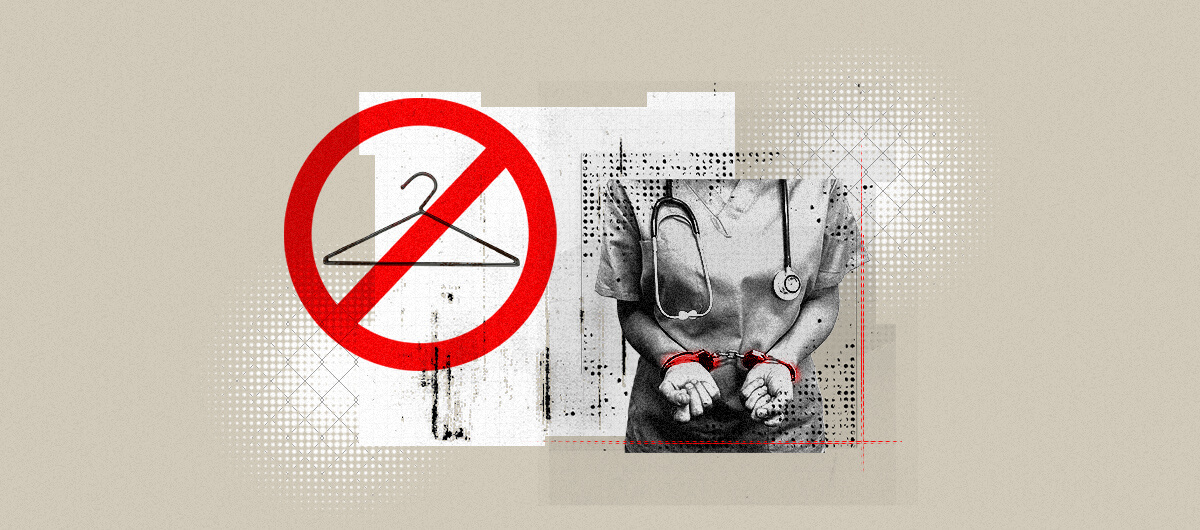

Body Politic
Our Biggest Health Care Risk Is Not a “Coat-Hanger Abortion”
At a time when health providers are being threatened with criminal charges even for tending to people having miscarriages, medical care has never been more inaccessible. Can we safely self-manage our health care?
This article was made possible because of the generous support of DAME members. We urgently need your help to keep publishing. Will you contribute just $5 a month to support our journalism?
If you’ve been to an abortion-rights protest any time in the past few decades, chances are good that you’ve seen a sign with a coat hanger on it. It’s a powerful image, one meant to evoke fear of a return to the era of the “coat hanger abortion”—a euphemism for the unsafe abortion methods that could feel like someone’s only option to terminate a pregnancy in the pre-Roe era. A world without legal abortion, the coat hanger sign warns, is a world where abortion-seekers ingest poison, insert coat hangers into their uteruses, and—the worst-case scenario—wind up dead.
Yet in the post-Dobbs era, the coat hanger imagery has begun to feel a little bit off. It’s not that America’s abortion bans haven’t been deadly. To the contrary, numerous women have died in Texas alone due to restrictions on abortion. But those deaths have come, not as a result of unsafe “back alley” abortions, but because of doctors denying life-saving medical procedures to people in the midst of miscarriages. Right now, the biggest risk a pregnant person will likely face isn’t a coat hanger, or a sketchy snake-oil salesman pumping them with poison, or any unsafe abortion at all. It’s a doctor who refuses to provide appropriate miscarriage care out of a fear of getting sent to prison for providing an abortion.
It’s a strange inverse of the scenario that we’ve long been taught to fear. And yet as abortion, gender-affirming health care, and other personal medical decisions become policed by the state and at times even criminalized, it’s a dynamic we’re likely to see more and more of. It’s not underground medical access that poses the most harm; it’s fully licensed doctors, nurses, and hospitals.
In the case of abortion care, the unsafe methods that proliferated in the pre-Roe era have been supplanted by mifepristone and misoprostol, a medication combo that can be ordered from the internet and taken at home. While self-managed abortion with pills can be uncomfortable and emotionally stressful—especially when done in a state where abortion is criminalized—from a physical perspective, it’s extremely safe. According to Doctors Without Borders, the chance of a “severe, life-threatening complication” is less than one percent. For the vast majority of abortion pill users, the experience will involve some cramping and discomfort, but no need to seek out additional medical care. While it’s unclear how many people have turned to extralegal sources to obtain abortion pills in the years since Dobbs, we know that the numbers are going up. And the longer abortion remains criminalized, the more likely it is that self-managed abortion will become, not a doomsday scenario invoked by pro-abortion protesters, but a routine part of life.
It’s a much different situation for the approximately 15 percent of pregnant people who wind up miscarrying. Of that group somewhere between 20 and 33 percent of people who have miscarriages will need a follow-up procedure. More specifically, they’ll need access to the exact same pills used in self-managed abortion or potentially a vacuum aspiration (which, what do you know, is a common abortion procedure). Rather than punishing abortion seekers—some of whom, ironically, feel a new freedom as self-managed abortion gives them the ability to have an abortion at home and on their own terms—abortion crackdowns have primarily served to make hospitals less safe for people who want to be pregnant.
Unsurprisingly, trans health care seems to be moving in a parallel direction to reproductive health care. As right-wing politicians push to make gender-affirming care increasingly inaccessible, it seems likely that more people will go underground to access their care—especially since finding ways to medically affirm one’s gender without the help of the medical establishment has long been a conversation within the trans community.
For years now, guides to DIY HRT have been available online. Oftentimes, these guides weren’t created due to fears of criminalization, but because the formal system of accessing gender-affirming care simply does not work for many trans people. In some cases, medical gatekeeping has created excessive hoops that deter, or outright prevent, trans people from accessing the care they need. In other cases, shoddy health insurance—or no health insurance at all—has made going through the legal medical system impossibly expensive. Whatever the reasons, resources have been created to help people understand how to appropriately manage their own HRT in order to get the results they want. It’s hard to imagine those resources going away any time soon.
None of which is to say that these DIY and underground solutions are a sufficient replacement for aboveboard medical clinics. At a bare minimum, the stigma created by criminalizing abortion and gender-affirming health care is reason alone to fight for full decriminalization of all reproductive and trans health care procedures. Moreover, studies of countries like Brazil, where self-managed abortion is commonplace, have shown that criminalizing abortion hurts women—regardless of whether they’re ultimately able to terminate unwanted pregnancies. DIY health care isn’t the right solution for everyone, and no one should need to turn to extralegal solutions just to feel comfortable in their own body.
But as we thread the needle on this thorny issue, it’s still important to remember that the division isn’t between “unsafe” medical care that’s obtained online or through unofficial channels and “safe” medical care that happens in a hospital. It’s between a world where people are given the freedom and space to make choices about their own reproductive health and gender presentation, and a world where criminalization makes that impossible. The coat hanger may be a symbol of the many times when going underground in search of medical care was a risky, even fatal choice. But it’s important for us to remember that that path can be a life-saving one as well.
Before you go, we hope you’ll consider supporting DAME’s journalism.
Today, just tiny number of corporations and billionaire owners are in control the news we watch and read. That influence shapes our culture and our understanding of the world. But at DAME, we serve as a counterbalance by doing things differently. We’re reader funded, which means our only agenda is to serve our readers. No both sides, no false equivalencies, no billionaire interests. Just our mission to publish the information and reporting that help you navigate the most complex issues we face.
But to keep publishing, stay independent and paywall free for all, we urgently need more support. During our Spring Membership drive, we hope you’ll join the community helping to build a more equitable media landscape with a monthly membership of just $5.00 per month or one-time gift in any amount.




















































































